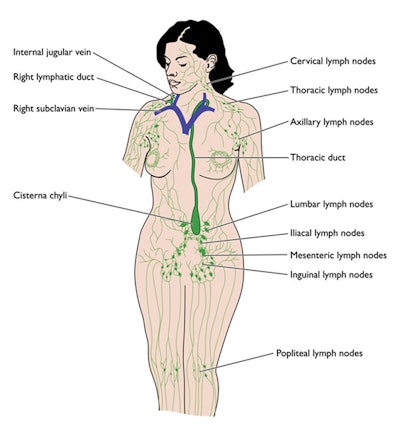
Human anatomy holds many marvels, and the interaction of intricate, complete body systems establishes optimum health and wellness. One of the most intriguing and dynamic relationships that the human body possesses, is that of the immune system and lymphatics. Lymph has long been researched and upheld by many physicians and therapists as the “elixir of life.”
From an esthetic perspective, one of the most famous and reputed practitioners of lymphatic drainage is Danish physician Emil Vodder, M.D., and his wife Estrid who developed the famous Vodder method and philosophy of manual lymphatic drainage (MLD). This philosophy involves the medical specialty called lymphology—the science and study of the lymphatic system, its functions, pathology, mechanisms and related body fluids.
While treating patients with chronic colds, Vodder recognized the correlation of swollen lymph nodes with many illnesses and began intensive research in the physiology of lymph, specifically facilitating natural healing through lymphatic functions and the immune system. Contrary to traditional medical protocols for the treatment or interruption of the lymphatic system during illness, Vodder developed specific hand and pressure movement techniques to effectively and efficiently improve the flow of lymph, facilitating the abatement of symptoms and re-establishing health.1 The application of MLD has evolved into a highly effective modality performed by estheticians and massage therapists throughout the world.
The Lymphatic System
The lymphatic system is a complex organism and network comprised of lymph vessels, afferent and efferent lymphangions, lymph nodes, lymphoid tissue and the unique body fluid, lymph. One of the primary functions of lymphatic vessels is to work in succession to detoxify and regenerate tissues, thus helping to maintain a healthy immune system. MLD is used to transport disease-producing substances at a faster rate to the lymph nodes, where they are destroyed. Lymph nodes, vessels and tonsils filter out potentially toxic materials and destroy microscopic foreign particles that are dangerous to the body.
The lymphatic system also is responsible for returning proteins and water from the interstitium to the cardiovascular system. The system is delicately intertwined and dependent on the blood circulatory unit; however, the two systems are distinctly different. Lymph circulation differs from blood circulation in that the lymphatic system lacks a central pump like the heart. Unlike blood circulation, lymph circulation is not in continual flow in all parts of the body at all times. It relies on several types of pressure, described next, to transfer lymph via lymphatic pathways, nodes and vessels.2
Capillary hydrostatic pressure (fluid diffusion and reabsorption). This capillary pressure forces lymph fluid out of blood capillaries. This fluid contains oxygen and nutrients that migrate to areas where they are less concentrated.3, 4
Oncotic Pressure. This form of osmotic pressure is related to the presence of proteins in blood vessel plasma, which tend to draw water into the circulatory system.5
Tissue Pressure. Various types and weights of pressure to any given surface area of the body will exert force or pressure on edema and blood capillaries.5, 6

Lymph circulation also depends on other factors such as muscle contraction, movement, pressure changes, spontaneous contractility of lymph vessels, external massage and gravity. Practices that help facilitate the flow of lymph include: physical exercise, dry body brushing, massage therapy, deep breathing such as that practiced in yoga, rebounding (bouncing on a mini trampoline) and of course MLD massage. Regarding deep breathing, lung and diaphragm activity will produce certain levels of pressure in the thoracic ducts and will influence transportation of lymph in that area.
There are about 600-700 lymph nodes located throughout the body (see Female Lymphaic System), and they are positioned in regions of potentially increased exposure to disease-causing agents, such as the respiratory structures and digestive track. Lymph nodes range in size from approximately 0.5 cm to 2.0 cm depending on the immune status, or if infection is present.
There also are collections of lymph nodes in the neck, axilla and groin. Respectively, the lymphatic regions are segregated into “watersheds” or compartments where lymph transfers and resides.7 During MLD, each watershed is opened to receive incoming lymph by specific fingertip drainage palpations. For the treatment to be effective, it is important for each watershed compartment to be activated and drained before encouraging incoming lymph flow.
The spleen is actually a large lymph node located along blood vessels rather than lymph pathways. It is considered the lymph node of the blood. Immune reactions can occur anywhere in the body, but the lymph nodes and spleen are where most activities take place. The vitality of circulation and rapid current transfer of lymph encourages a more dynamic metabolism, resulting in favorable conditions for a healthy functioning immune system and body.
Lymph itself is composed mainly of water, salts and dissolved proteins. It produces millions of white corpuscles and antibodies for immune defenses. All biochemical processes in the body are made possible via lymph flow through the cells. Lymph is almost colorless, naturally alkaline and similar to blood plasma except lymph contains mainly white blood cells.
Lymphatic Defenses and Detoxification
One of the unique tasks of the lymph nodes is to “corral” immune cells. The lymph nodes and relative tissues—thymus, spleen and bone marrow—are respective sites where lymphocytes are produced. Lymph is formed by a surplus of interstitial fluid that is not re-absorbed by the capillaries. It contains lymphocytes, which play an important role as they contribute toward the defense mechanisms of the body, helping humans withstand microbial infection and intervening in the immunological defenses of the body by producing immunoblasts. Immune functions activate dendritic cells, which are involved in the activation of B and T cells, and immediately begin disassembling bacteria in lymph nodes by signaling lymphocytes to help fight infection.
The lymphatic system also helps to repair damage in injured tissues and rids the body of excess proteins and toxins via excretion through the primary detoxification organs: the liver, colon, lungs, bladder, kidneys and skin. The first defense of the immune system consists of physical barriers including the skin, mucosa and secretions from the mucosa such as mucus. Mucus is secreted from the lymphatic system and synthesized from sugars, proteins and fat floating in lymph fluid.
Mucous often is produced in excess due to the body’s protective response to irritating wastes and infections. Mucous is generated by goblet cells and forms along the epithelial lining of the bronchi, trachea, small intestines and large intestine. Mucous is produced to protect the delicate membranes from irritants, bacteria and viruses. However, the excessive accumulation of wastes in the body, and in particular the colon, may trigger responses from the respiratory system and sluggish digestive tract. Signs of lymphatic congestion include an excess of mucous in the body, which may trigger frequent colds, chronic cough, bad breath, nasal drip, congested ears and sore throats.
The Healing Crisis
One of the potential side effects of MLD, reflexology, energy work or deep tissue massage is what is referred to as the healing crisis or “Herxheimer Reaction.” Although not a general occurance, this reaction may present itself in some individuals with dizziness, light-headedness, low grade fever, joint and muscle tenderness, skin eruptions and heightened emotional feelings.
Toxins that are stored in blood located in the fascia, adipose tissue and primary muscle are coaxed out by MLD therapy into the bloodstream. In cases where the body tries to rid itself of the toxins faster than they can be disposed of, these temporary symptoms may manifest. It is imperative to complete a health intake form before any advanced massage modality is used, and that the client is well-hydrated before and after the session. Preliminary assessment will help and to assist and gauge the potential for such reactions.8
Cells Need a Bath
In chronic cases of lymphatic stagnation, cells can become dehydrated, which encourages the calcification of cells that impact vital cellular functions. As these functions are compromised, tissues may become toxic as a result of their own waste products and contribute to accelerating aging. Lack of circulation and oxygenation will cause tissues to become more acidic, resulting in a hardening of the muscles and fibrotic changes that can lead to infiltrative pain, edema and stiffness. A faster natural flow of lymph circulation and stimulation is will eliminate more waste products.
Connective tissue is a receptacle for body fluids, and it supplies water directly to the glands and organs to keep tissues moist and healthy. All biochemical processes throughout the body are only possible by lymph flowing through the cells.
The water in our bodies is composed of two distinct fluids: intracellular and extracellular.
Intracellular.The intracellular cytoplasmic matrix is found inside the cells and contains organelles, proteins, sodium, potassium, magnesium and sulfate ions dissolved in water. In humans, the intercellular compartments contain approximately 28 liters of fluid.
Extracellular. This fluid includes water, electrolytes, protein, glucose, enzymes and hormones. The adult body contains about 11.2 liters of interstitial fluid (16% of body weight) and about 2.8 liters of plasma (4% of body weight). Plasma and interstitial fluid are similar chemically and, in conjunction with intracellular fluid, help control the movement of water and electrolytes throughout the body. Some of the important ionized components of extracellular fluid are protein, magnesium, potassium, chlorine, calcium and certain sulfates.9, 10
Lymphatics and the Skin

A well-functioning lymphatic system will influence the tone, color and clarity of skin. As a result of the aging process, lymphatics become less active and facial edema may occur. Inadequate lymph activity is directly attributed to puffiness and dark circles under the eyes as well as swelling of the ankles and face.
Acne. Cellular fluids that surround acne pustules contain inflammatory mediators as well as toxins that should be eliminated for acne to heal. MLD facilitates the drainage of unwanted bacteria and cellular debris away from the pustulous region. Any pathogenic material, cell fragment proteins and wastes that manage to cross immune barrier mechanisms of the skin may be transported to lymph pathways for removal. MLD efficiently triggers immunologic activity of the body to facilitate transfer of wastes and encourage healing naturally with noninvasive techniques.11
Rosacea. Rosacea has been responsive to MLD, as the drainage of capillaries and lymphatics may be decongested through variations in hydrostatic pressure. As a result of vascular alterations in rosacea and accompanying edema, the neurovascular functioning of the skin facilities phymatous changes as seen in rhinophyma. A recent study from the National Rosacea Society has confirmed that the fibrous changes occurring in advanced stages of rosacea (rhinophyma) are the result of chronic lymphedema.12 Certain sensory nerves around blood vessels may also be linked to stinging and rosacea development. The balance between several neuropeptides may be disrupted in rosacea skin types and may cause swelling (edema), affecting the lymph vessels as well.
Martin Steinhoff, M.D., of the Dublin School of Medicine states, “The skin of the face is one of the only places where the sympathetic, parasympathetic and sensory nervous systems all play a role, and can influence and amplify each other’s effects. This may create a complex cycle of inflammation through multiple mechanisms, which may explain why some cases of rosacea may be resistant to treatment.”13, 14 It is important for estheticians to understand the functioning and malfunctioning of blood vessels in conjunction with lymphatics, as they both are influenced by a mechanical and chemical environment.
Pigmentation. Various pigmentation developments are also correlated with lymphatic function and irregularities. Lipofuscin can be found in lymphatic nodes as a result of oxidized fats from cells or toxins accumulating as cellular waste. As these wastes are carried throughout lymph and may not efficiently be cleared for removal, they may appear as pigment in the skin. They are often called “liver spots.” Lipofuscin is correlated more with age than the liver itself and should not be confused with seborrheic keratoses.
Lipofuscin pigment accumulation is mitigated from lymphatic channels and may be deposited into dermal tissue to eventually reside in the epidermis. As this pigment is not normal melanin, it will not respond to traditional pigmentation therapy. However, there are preventative measures that may ward off its development, such as supplementation with glutathione and acetyl-l-carnitine.15
Better Overall Health
The vitality of the lymphatic system mirrors the skin’s health and ultimately, one’s overall health. MLD remains one of the most effective methods to assist in the management of problematic and congestive skin conditions. It also requires no equipment and benefits both the client and technician. Since its application requires manual dexterity and palpation, training for MLD should be taught hands-on and through an experienced provider well-versed in anatomy, MLD technique and lymphatics.
MLD remains truly one of the most treasured modalities from traditional European esthetic training, and may be integrated into the holistic, spa or clinical setting to support beauty through health.
References
- https://en.wikipedia.org/wiki/Emil_Vodder
- www.ncbi.nlm.nih.gov/books/NBK53448/
- https://arh.adam.com/pages/guide/reftext/html/lymp_sys_fin.html
- Studies/Phlebolymphology_Tissue_fluid_pressure_and_flow_in.aspx
- https://cvphysiology.com/microcirculation/m010
- biocompression.com/PDFs/Lymphedema
- https://en.wikipedia.org/wiki/Lymphatic_system#/media/File:Lymph_node_regions.svg
- integrativehealthcare.org/mt/archives/2006/10/how_to_prepare.html
- boundless.com/physiology/textbooks/boundless-anatomy-and-physiology-textbook/body-fluids-and-acid-base-balance-26/body-fluids-246/fluid-compartments-1208-1206/
- https://en.wikipedia.org/wiki/Fluid_compartments
- amazon.com/Textbook-Vodders-Manual-Lymph-Drainage/dp/3131373776
- rosacea.org/patients/causes/neurovascularsystem
- amazon.com/Compendium-Vodders-Manual-Lymph-Drainage/dp/3830406673
- rosacea.org/rr/2000/summer/article_4.php
- http://blog.pharmacymix.com/lipofuscin-when-pigmentation-isnt-hyperpigmentation
(Websites accessed Jan 24, 2017)
Further Studies
- vodderschool.com
- H Wittlinger, D Wittlinger, A Wittlinger and M Wittlinger, Dr. Vodder’s Manual Lymph Drainage: A Practical Guide, Thieme Publishing Group: Stuttgart, Germany (2011)
- sciencedirect.com/science/book/9780323030649
- lymphedemastore.com/dvd-basic-techniques-of-manual-lymph-drainage/
- amazon.com/exec/obidos/ASIN/0962773433/bomi0e
- sustainabletable.org/797/rbgh
(Websites accessed Jan 24, 2017)











